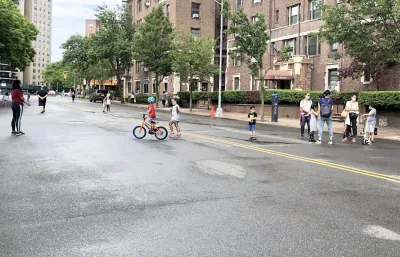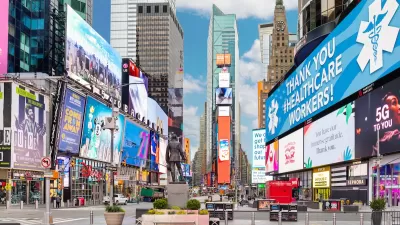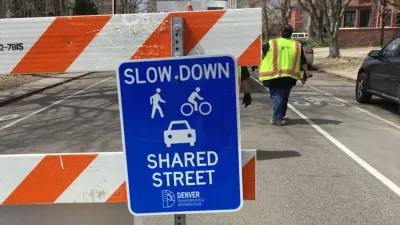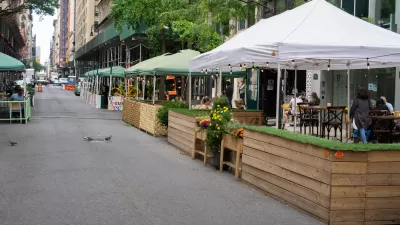The number of open streets projects has dropped year after year as volunteer groups struggle to fund and staff them.

New York City’s open streets, like its outdoor dining patios, continue to wane with little support from city officials. “The downward trends of the open streets over four years confirm Streetsblog's extensive reporting on the steady rollback of operating days and hours across the city,” writes Kevin Duggan in Streetsblog NYC.
According to city Comptroller and mayoral candidate Brad Lander, “Volunteer groups cannot sustain the work to successfully operate open streets without more resources, support, and clear guidelines from the city.” Lander called on the city to expand and support the program.
The average number of open streets in the city dropped from 326 in 2021 to 232 in 2024. This year, the program is expected to roll out in 127 locations. “The average length of city open streets dropped by nearly a third (32 percent) between its peak in 2020 and 2024, and operating hours per week fell by 40 percent, according to the comptroller's analysis.” The projects that remain are concentrated in Manhattan, which consistently has the highest number of open streets compared to the other boroughs.
Lander’s report recommends bringing the program to all neighborhoods and creating a “baseline reliable public funding” source to support neighborhood volunteer groups with setup and equipment costs. Recently, a group of Open Streets organizers requested $48 million from the city over the next three years. According to Lander, “If you provide resources to enable open streets to happen, not only will you have a beautiful open street, but you’ll be supporting the growth of a neighborhood safety institution, [New Yorkers] would think that $48 million was a bargain.”
FULL STORY: Open Streets Are Shrinking Thanks to ‘Lukewarm’ City Support: Lander

Planetizen Federal Action Tracker
A weekly monitor of how Trump’s orders and actions are impacting planners and planning in America.

Congressman Proposes Bill to Rename DC Metro “Trump Train”
The Make Autorail Great Again Act would withhold federal funding to the system until the Washington Metropolitan Area Transit Authority (WMATA), rebrands as the Washington Metropolitan Authority for Greater Access (WMAGA).

The Simple Legislative Tool Transforming Vacant Downtowns
In California, Michigan and Georgia, an easy win is bringing dollars — and delight — back to city centers.

The States Losing Rural Delivery Rooms at an Alarming Pace
In some states, as few as 9% of rural hospitals still deliver babies. As a result, rising pre-term births, no adequate pre-term care and harrowing close calls are a growing reality.

The Small South Asian Republic Going all in on EVs
Thanks to one simple policy change less than five years ago, 65% of new cars in this Himalayan country are now electric.

DC Backpedals on Bike Lane Protection, Swaps Barriers for Paint
Citing aesthetic concerns, the city is removing the concrete barriers and flexposts that once separated Arizona Avenue cyclists from motor vehicles.
Urban Design for Planners 1: Software Tools
This six-course series explores essential urban design concepts using open source software and equips planners with the tools they need to participate fully in the urban design process.
Planning for Universal Design
Learn the tools for implementing Universal Design in planning regulations.
Smith Gee Studio
City of Charlotte
City of Camden Redevelopment Agency
City of Astoria
Transportation Research & Education Center (TREC) at Portland State University
US High Speed Rail Association
City of Camden Redevelopment Agency
Municipality of Princeton (NJ)





























